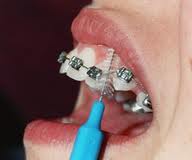Orthodontics is the art of repositioning the teeth in the mouth, and is traditionally thought of as something only buck-toothed children go through. In fact, orthodontics helps a host of positional problems in the mouth, in both children and adults.
Take for example, some one with a large gap between his front teeth. There are several ways to close that gap, depending on what caused it, where it is, and the state of health of the surrounding teeth. You could restore the teeth through the use of a crown, or you could remove the affected teeth and replace them with a bridge or implants, which is clearly the least desirable option. Alternatively, you could reposition the teeth using orthodontics: the ideal treatment when your teeth are healthy and look attractive, because you don’t lose some of the healthy parts of your teeth as you would during crowding. You simply move the teeth in the gums and put them in a more attractive position.
Orthodontics is mostly used for cosmetic reasons such as straightening teeth or closing gaps. You might have buck teeth, or you might have very skew teeth. Perhaps you have a gap that has bothered you all your life. If your teeth are healthy, but your simle needs improvement, orthodontics may be the way to go.
Orthodontic treatment does take a long time, there’s no getting away from it. You’re looking at six months to three years, depending, of course on what your particular problem is, and you will require regular checkups and adjustments to ensure the desired result is achieved. However, modern braces are far less visible (as compared to the traditional full-sized braces), and treatment may be as simple as a retainer plate for a couple of months.
Traditional Braces

Mini Braces

Lingual Braces
These days, some problems may be corrected with lingual braces. These are mounted on the back surface of the teeth, and are virtually invisible. If those are not an option for your problem, you can also have clear plastic/crystal brackets fitted to your teeth instead of traditional metal ones, which also reduces their visibility to others.

Crystal Braces
Unlike ceramic brackets that are opaque and colored to mimic a particular tooth shade, clear brackets are crystal clear and virtually disappear regardless of tooth shade. For more info, click here

Of course, there are possible complications, of which you should be aware. In some cases, the teeth move back to their original positions. This is the reason you are required to wear a retainer plate that ensures the teeth stay put after the actual treatment. In additional, loose bands on the teeth can create decalcified areas where decay can begin. However, this is not common, and modern bonding methods ensure the brackets are fixed to the teeth in such a way that the risk of decay is greatly reduced.

Invisalign Aligner

Invisalign is a well known clear aligner used to correct misaligned teeth with ease and comfort from the US.
Mbrace Aligner

MBrace is a clear aligner used to correct misaligned teeth with ease and comfort. It is clear and removable which makes it almost unnoticeable by others and convenient to use. The aligners are custom-made digitally and fabricated individually to ensure a perfect and accurate fit for your teeth.
Treatment can be performed by a general dental practitioner who has sufficient training in orthodontic field or by an orthodontist who specializes in this field. Generally, your dentist refers you to an orthodontist, with whom you make an initial appointment, so that he can assess the state of your teeth and propose a treatment plan. It is good idea, at this stage, to discuss cost implications, as orthodontic treatment can be very costly, and you need to know what you are letting yourself in for.
 Your treatment plan may consist purely of braces and retainers, just retainers, or may even require that two or more teeth are removed to make space in your mouth. For example, you may have buck teeth in your mouth because there simply wasn’t enough space for all your adult teeth in your gums when they erupted. To correct this, the orthodontist may have to extract the back molar on each side of the top set of teeth to make extra room in your mouth. This then allows him to move the remaining teeth into a more favorable position.
Your treatment plan may consist purely of braces and retainers, just retainers, or may even require that two or more teeth are removed to make space in your mouth. For example, you may have buck teeth in your mouth because there simply wasn’t enough space for all your adult teeth in your gums when they erupted. To correct this, the orthodontist may have to extract the back molar on each side of the top set of teeth to make extra room in your mouth. This then allows him to move the remaining teeth into a more favorable position.
Also don’t forget to ask the orthodontist how long the treatment is likely to take. It’s a lot easier to put up with braces if you know when they’re likely to come out. All in all, however, orthodontics is a painless procedure; there is some initial discomfort from braces or even from a retainer, but this generally disappears after a few weeks. It’s more a case of getting used to the foreign objects in your mouth than them causing discomfort.
More info
- Orthodontic Treatment
- Orthodontic Consultation
- Fix appliance vs. Removable appliance
- Cases with fix appliance
- Orthodontic with Damon System
- Clear Bracket System
- Clear Aligner with Invisalign® — Invisible braces
- Clear Aligner with MBrace® — Invisible braces
- Orthodontic Limitations & Potential Risks
- Braces for young children
- Braces for jaw surgery
- FAQ on orthodontic
…





![DSC_0007 [1600x1200]](https://prestige-dental-care.com.my/wp-content/uploads/2011/02/DSC_0007-1600x1200.jpg)





























![Treating patient [1600x1200]](https://prestige-dental-care.com.my/wp-content/uploads/2011/02/Treating-patient-1600x1200.jpg)



![Consultation01 [1600x1200]](https://prestige-dental-care.com.my/wp-content/uploads/2011/02/Consultation01-1600x1200.jpg)



























